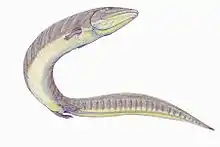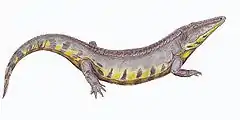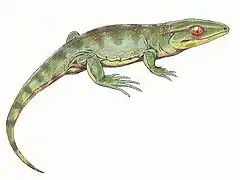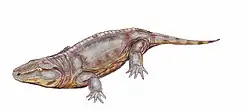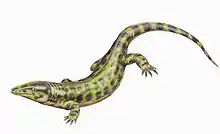Desmatodon
Desmatodon is an extinct genus of diadectid reptiliomorph. With fossils found from the Kasimovian (Missourian) stage of the Late Carboniferous of Pennsylvania, Colorado, and New Mexico in the United States,[1] Desmatodon is the oldest known diadectid. Two species are currently recognized: the type species D. hollandi and the species D. hesperis.
| Desmatodon | |
|---|---|
| Scientific classification | |
| Kingdom: | Animalia |
| Phylum: | Chordata |
| Order: | †Diadectomorpha |
| Family: | †Diadectidae |
| Genus: | †Desmatodon Case, 1908 |
| Species | |
Description
Remains of Desmatodon have been found from the Glenshaw Formation of Pennsylvania, the Sangre de Cristo Formation in Colorado, and the Cutler Formation of New Mexico. The genus is known mostly from teeth and portions of skulls. The cheek teeth are robust and spade-shaped with several cusps on their surfaces. The two species can be distinguished by the distribution of teeth in their jaws; D. hesperis has tightly packed teeth while D. hollandi has widely spaced teeth. In both species, the lower jaw is deep and possesses a ridge that may have aided in chewing plant material. Some specimens that are thought to belong to young individuals have fewer, more widely spaced teeth with no wear facets.[2]
Paleobiology
Like most other diadectids, Desmatodon was a terrestrial herbivore that consumed high-fiber plants. Protruding incisiform teeth and a large digestive tract may have allowed the animal to effectively consume and digest plant material. Being the oldest diadectid, Desmatodon also is the oldest known herbivorous land vertebrate.[2]
References
- Voigt, S.; Ganzelewski M (2010). "Toward the origin of amniotes: Diadectomorph and synapsid footprints from the early Late Carboniferous of Germany" (PDF). Acta Palaeontologica Polonica. 55 (1): 66. doi:10.4202/app.2009.0021. Retrieved 3 December 2012.
- Kissel, R. (2010). Morphology, Phylogeny, and Evolution of Diadectidae (Cotylosauria: Diadectomorpha). Toronto: University of Toronto Press. p. 185. hdl:1807/24357.
